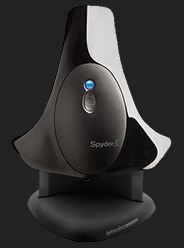I’ve had some good conversations lately with a number color scientists and gurus about colorimeters and display calibration. Several of them perform exhaustive lab tests on a variety of devices, checking for repeatability and the like. The consensus seems to be that while the long time favorite DTP94/Optix device continues to be a solid performer, it’s been found to have some weaknesses when it comes to calibrating some of the recent large gamut LCD/LED displays. As for other devices, the EyeOneDisplay continues to have quality control problems, spectrophotometers have issues with shadow detail when it comes to display calibration and the Huey is an inexpensive solution that demanding users shouldn’t take seriously.
Surprisingly to some, the new 7-sensor Spyder3 has excellent repeatability and it performs remarkably well in a variety of situations, especially with the latest large gamut displays and projectors. It looks like the Datacolor Spyder3 has trumped the Optix colorimeter as the best and most versatile colorimeter made today. Eizo and others are starting to bundle rebranded Spyder3s with their high end monitors. My own testing has shown that the Spyder3 performs just as well as the trusted Optix and clearly better than the others. I like the fact that the Spyder doesn’t require dark calibration prior to each use and it comes with a nice holder complete with a tripod mount for projector calibration.
While the Spyder 1 and 2 were disappointing for demanding users, I’ve got to hand it to them for turning this product around and making it the best in the industry. Datacolor sells a basic "Spyder 3 Pro" package for $169 and a more advanced "Spyder 3 Elite" package for $249. The hardware is not only the best thing made but the software is really easy for anyone to use and the “elite” version of the software is surprisingly capable with advanced features like L* tonal response curve, black luminance control and ambient light integration.
Integrated Color sells a display calibration product called Color Eyes Display Pro that’s been a favorite among demanding professionals for several years. Color Eyes Display Pro is now bundled with the Spyder3 device and I find it to render slightly superior shadow tonality and gradations.
For common monitor calibration, I am currently recommending the basic $169 “Spyder3 Pro” package to consumers and the new $299 Color Eyes Display Pro / Spyder3 bundle for demanding professionals.
Note: CRT users should put a black cloth over the monitor and Spyder when calibrating to eliminate ambient light contamination. Those using Eizo, NEC and Quato displays should stick with the supplied software to calibrate their displays. Eizo’s Color Navigator, NEC’s Spectraview, and Quato’s iColor Display have all become quite good and can have advantages over 3rd party solutions. Use the Spyder3 device with these applications when possible.
